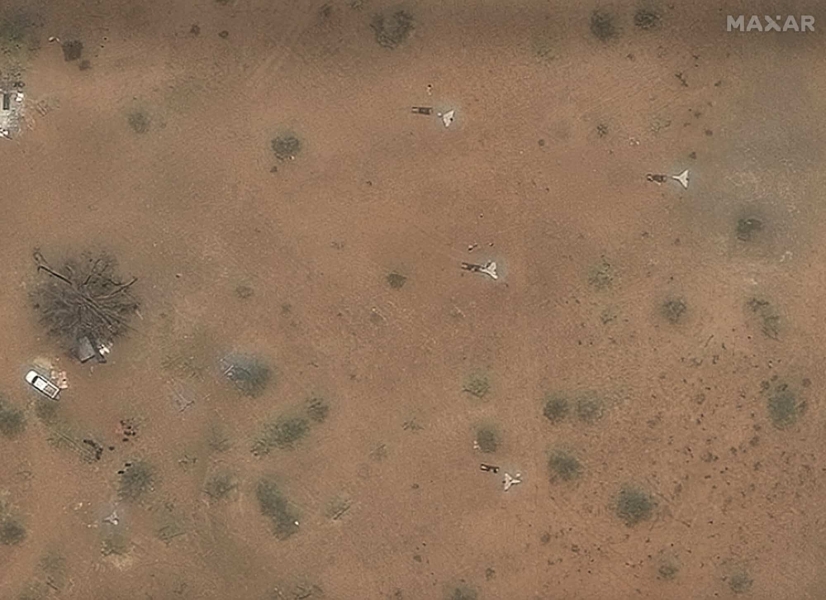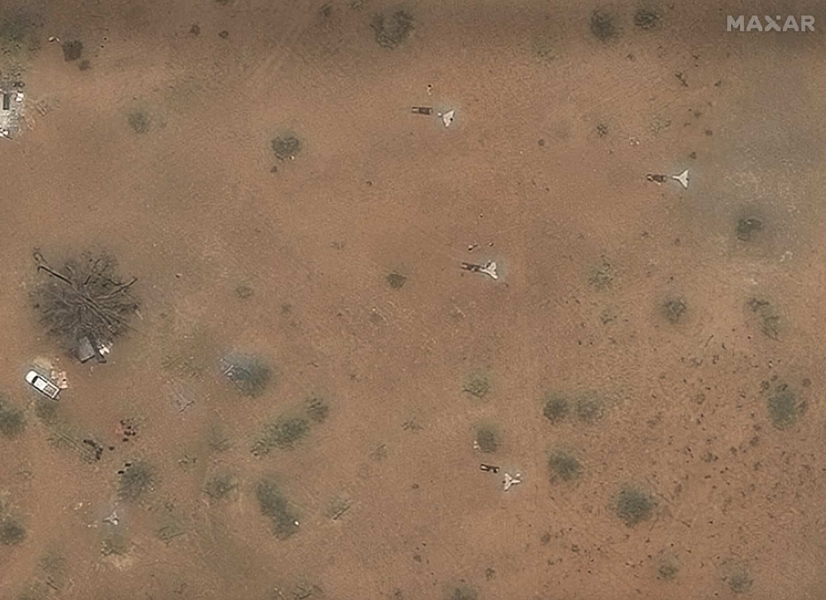Kamikaze Drones With 1,200-Mile Range Spotted In Sudan’s Darfur Conflict
A May 6, 2025 satellite view captures long‑range “suicide” drones and launch equipment north of Nyala Airport in Sudan. Maxar Technologies/Handout.
“has-text-align-left”>
More than a dozen advanced kamikaze drones with ranges of up to 2,000 kilometers (1,200 miles) were identified near Nyala airport in Sudan’s Darfur region in May, signaling a major escalation in the Rapid Support Forces’ (RSF) drone capabilities, according to images analyzed by the Yale Humanitarian Research Lab and verified by Reuters.
The new presence of long-range suicide drones represents a turning point in the ongoing war between the RSF and the Sudanese army, raising the risk of an expanded conflict in a country already facing severe humanitarian collapse. The findings suggest that Sudan’s paramilitary forces may now possess aerial strike capabilities able to reach anywhere in the country, potentially altering frontlines and regional power dynamics.
Evidence of Advanced Drone Systems
Satellite imagery from May 6 reportedly revealed 13 delta-wing drones positioned with 16 launch platforms at Nyala airport, an RSF stronghold in western Darfur. These drones, designed to crash into and destroy targets, are estimated to have a 2,000 km range, vastly exceeding the reach of earlier RSF-operated Chinese-made CH-95 drones, which max out at about 200 km (120 miles).
Yale analysts concluded the aircraft were consistent with one of two possible Chinese models, though they did not confirm a manufacturer. Independent defense experts contacted by Reuters agreed on the estimated range but noted that similar long-range models are also produced in Russia and Iran. China’s foreign ministry denied any involvement, stating Beijing “has always adopted a prudent and responsible attitude in military exports” and complies with United Nations regulations.
Strikes Linked to Presence of New Drones
The drones appeared in Darfur just as Port Sudan, located 1,600 km (995 miles) away, came under a series of kamikaze drone attacks between May 3 and May 9. Analyses suggest these strikes may have originated from the Nyala deployments. While Sudan’s army accused the United Arab Emirates of involvement, alleging launches from an Emirati Red Sea base, the UAE strongly denied the claims. By May 9, the drones at Nyala were removed, though their launchers remained visible into September, according to ongoing satellite monitoring.
Escalating Use of Armed Drones
Historically reliant on ground operations, the RSF has dramatically expanded drone warfare in 2024 after losing key territory in central and eastern Sudan. It has since used drones against military bases, fuel depots, and infrastructure, with the latest long-range systems signaling a possible shift to strategic strikes deep inside army-controlled areas. This week, the RSF confirmed drone attacks on Sudan’s capital Khartoum in what it described as retaliation for alleged military strikes on civilians. The army has denied targeting civilians.
Earlier in the year, Reuters documented the RSF operating three Chinese-built CH-95 drones at Nyala airport, highlighting the steady progression in the group’s UAV arsenal. Darfur, however, remains under a longstanding arms embargo frequently violated since its establishment in the early 2000s, leaving open questions on how the new systems entered the region.
Implications for Sudan’s Civil War
Independent defense analyses by Janes and by Wim Zwijnenburg of the Dutch peace organization Pax verified that the Nyala drones were long-range delta-wing suicide drones. Their deployment underscores the growing technical sophistication of the RSF despite international restrictions, a development that could reshape the conflict’s trajectory and deepen instability in the strategic Red Sea nation.
DroneXL’s Take
The arrival of long-range kamikaze drones in Darfur represents another troubling evolution in the global proliferation of military drones. Their use in Sudan highlights how non-state groups can rapidly expand air capabilities, challenging conventional forces and complicating international oversight. Key questions remain: how did these aircraft breach the long-standing arms embargo, and what role might regional actors have played in supplying or enabling their use?
If the RSF can sustain the operational use of drones with a 1,200-mile reach, Sudan’s fragile balance between factions and regional powers could tilt further toward a protracted, decentralized war. For the drone industry and policymakers, this episode raises urgent concerns about the transfer and control of long-range strike UAVs.
What do you think the global drone community should learn from Sudan’s unfolding drone war? Share your perspective in the comments below.


